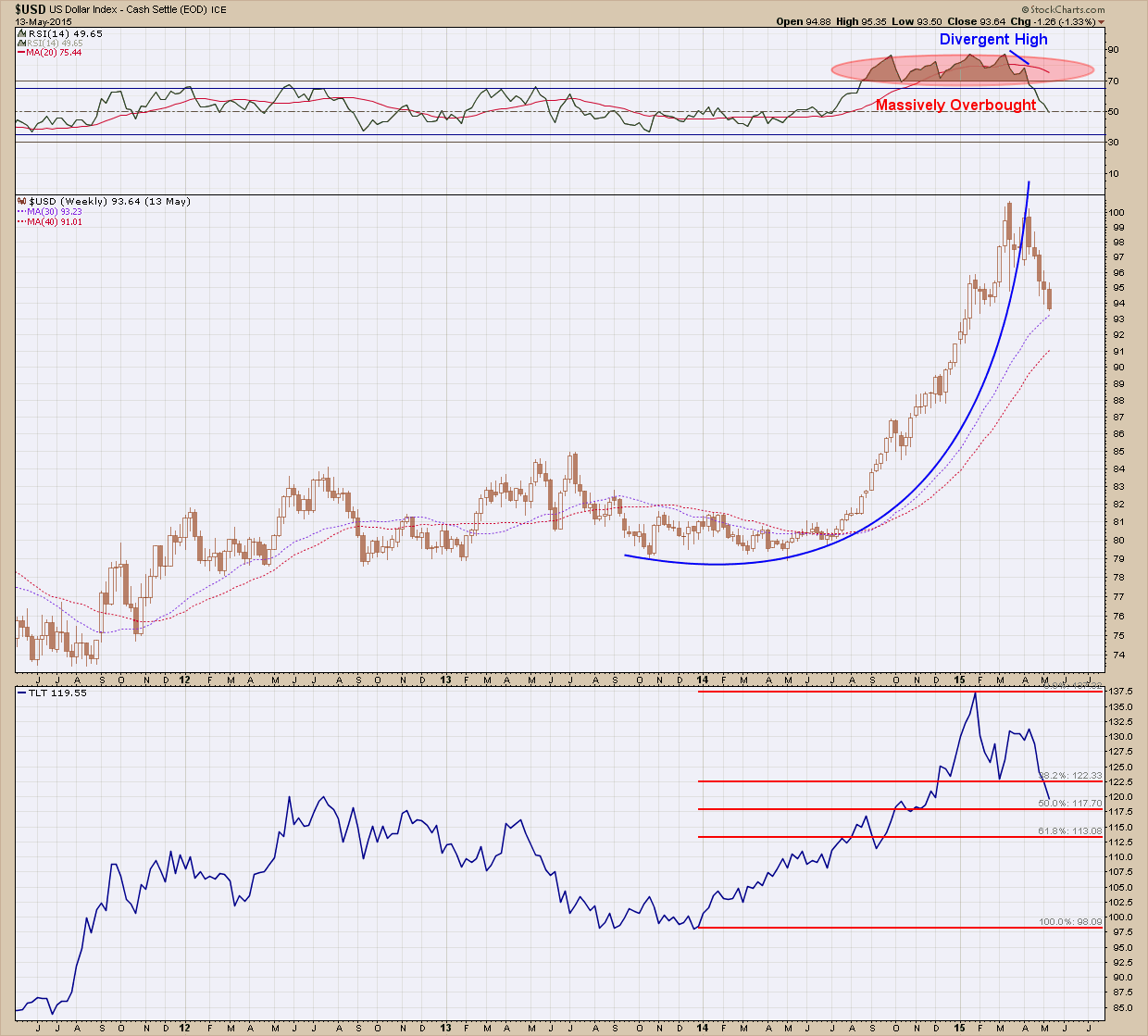I wanted to take a look at bonds for this post as we have been in the midst of a nasty intermediate term correction where the 20 year bond has lost 13% over the past 3 months. One needs to look no further than the US dollar for a major source as the correlation between the two is strong.
The chart below is split into 3 panes. The upper pane is a measure of US Dollar momentum, the middle is the US Dollar price and the lower is my proxy for bonds, TLT, price of the 20 year treasury. It’s easy to see the bottom of the dollar coincided with a bottom in bonds back in late 2013. The dollar broke out of its consolidation pattern and began a parabolic rise where at the start of 2015 it created a divergent high (price is moving higher while momentum is falling). This, combined with a massively over-bought condition was the warning shot a correction (not a reversal) was forthcoming. As the dollar has fallen, as you can see the affect it has on bonds as they have fallen along with it.
So now what? Is the end for the dollar and therefore bonds? Is it time to panic and follow Sonny’s plan in the Godfather and hit the mattresses? The prognosticators have been proclaiming the end of the dollar for years, is that fateful day finally upon us? Not as far as I am concerned. As with all investments when the price moves too far too fast a consolidation is necessary in order to build up enough strength (find more buyers) in order to move higher. Consolidations can be sideways or downward in their direction and be short lived or uncomfortably long. A good rule of thumb is to expect their duration to be proportional to the strength of the movement in price. Additionally, because of the long base in which the dollar broke out of, its target is expected higher beyond the recent peak and will likely take a long time to complete (years). So, in spite of the negative short term impact to portfolios and the top pickers calling for Armageddon, the long term view is still compelling for the dollar. Whether bonds continue their positive correlation and follow in the dollar’s footstep or not only time will tell but I do think for at least the near future the two will continue to move in lockstep.
Because we have formed positive divergence on the shorter term daily chart and we are approaching the 50% Fibonacci retracement, I expect we see this latest consolidation run its course sooner rather than later. Keep in mind the real tell will be not where or when this correction ends but instead where the reflexive bounce up from here takes us. If it turns out that bounce creates a lower high, that would be my signal to shorten up maturities and follow Sonny’s recommendation to hunker down and lay low. But until then, don’t fight the trend and suck it up as this is likely only a correction, not a top.
Charts are great tools to bring clarity to noisy, volatile markets but we need to respect the fact that in the end they can be overridden by news and manipulation. I hesitate to use the word manipulation because markets, if large enough, should be able to shrug off (long term) manipulation. But I hope everyone understands I am not wearing my tin foil hat because both bonds and currencies are two markets which have well-armed, locked and loaded central banks and Governments around the world intervening daily. That is not conspiracy: it is fact. As such, we always take our investment queue and game plan from the charts but realize things can change very quickly which is why we create an exit strategy for every investment BEFORE entering just in case the market wants to prove us wrong.
At some point, like all bull markets, this bond bull will die too. Its death is not what scares me but instead it will be the fact that I expect most investors will be caught flat-footed. It’s been more than 30 years since this bull market started and very few have a plan for when it ends. Additionally, it is unlikely they have they been investing long enough to have lived through a prior bear and as such will not recognize (or may have forgotten) what one looks like. Most importantly I question whether investors understand the magnitude of the impact to their investment portfolio when rates begin to rise. A general rule of thumb is that for every year of duration in their portfolio, a 1% rise in interest rates will create a proportional loss in their bond holdings. So what that means is if your portfolio has a duration of 20 years and interest rates rise 1%, you will lose ~20% on your bond positions. Are you prepared for this?
